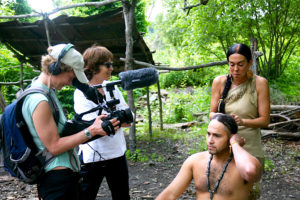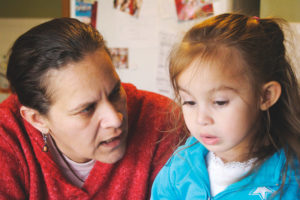The story of the Wampanoag nation, the confederation of Native American tribes who lived in what is now Cape Cod and the Islands, southeastern Massachusetts, and Rhode Island, is a constellation of tragedies, first among many in the English colonization of North America. But there is an uplifting thread to that history that is recounted in Anne Makepeace’s documentary film We Still Live Here, which she will screen at the Eastham Public Library on Saturday: it’s the revival of the Wampanoag language a century after it was considered dead — no longer spoken and essentially lost. This tale combines dreams and ancient tradition with science, history, technology, and community organizing, and it’s a tale that is still unfolding.

In an interview by email with the Independent, Makepeace disputes summing up the Wampanoag saga as tragic. “This is a story of a Native American community taking agency in reclaiming their language and reviving their culture after 400 years of a deeply challenging history,” she says. The film tells of “the indomitable character of Jesse Little Doe Baird, whose passion, intelligence, commitment, determination, and vision brought her community together in their amazing 20-year effort to unearth clues to the language and bring it back as a living language.”
The screening is part of a weekend of events that kick off Eastham’s commemoration of the 400th anniversary of the Pilgrims’ arrival in Massachusetts in 1620. The film is not new — it was released in 2011 — but recent efforts to include the Native Americans’ side of the story of colonization gives it a new context and relevance.
When the Pilgrims crossed the Atlantic, their first sight of land in the New World was Cape Cod. They were bound for Virginia, but when they turned south, the wintry seas and shoals around Chatham proved too challenging. They sought safe harbor in Provincetown for a few weeks before settling in Plymouth. A foraging party of colonists skirmished in Eastham with the indigenous Nauset (a Wampanoag tribe), an event known as the “First Encounter.” Shots were fired. No blood was shed.
In the first decades after the English colonists established themselves in Massachusetts, they saw it as their mission to convert Native Americans to Christianity. For that purpose, shortly after the 1636 founding of Harvard University, the Indian College was established there. The Indian College had a press, imported from England, which was used to produce the first Bible printed in the Western Hemisphere — the Eliot Indian Bible — in the Natick dialect of the Massachusett language. When the Wampanoag language eventually died out, this Bible would be instrumental in bringing it back to life.
Another important set of texts were handwritten deeds to lands throughout southeastern Massachusetts, dating from the 17th through the 19th centuries, many of which were signed by Wampanoag elders and included Wampanoag-language entries written in the Roman alphabet. One such document is the original deed to the town of Eastham, an 18th-century copy of which hangs today in the town administrator’s office.
In the 1990s, Jesse Little Doe Baird, who is a Mashpee Wampanoag, worked with linguists at the Massachusetts Institute of Technology, with the support of Noam Chomsky, to reconstruct the language, based on the old Wampanoag texts, supplemented by other indigenous languages that are still spoken. The film adroitly shows how she and other members of the Wampanoag tribe in Mashpee and Martha’s Vineyard worked assiduously to develop instructional materials, learn the language, and bring it back into common use in the community. Baird’s daughter, Mae, is the first native speaker of the language in the new generation, and Baird and others have been teaching other children of the tribe as well.

Baird earned a master’s degree from M.I.T. and was honored with a MacArthur Fellowship in 2010 and an honorary doctorate from Yale University in 2017.
Makepeace is not Native American. In fact, her direct ancestors were among the early inhabitants of the Massachusetts Bay Colony who fought against the Wampanoag in King Philip’s War, including at the 1675 battle known as the Great Swamp Massacre. (The war wiped out 40 percent of the Wampanoag population.) Makepeace says that when she confessed this to Baird, Baird responded, “You’re closing the circle.”
As the towns of Eastham, Provincetown, and Plymouth gear up to commemorate the 400th anniversary of the Mayflower’s arrival, they are making special efforts to include the Native American perspective. Eastham will get things started with the screening of We Still Live Here on Dec. 7. The following day, there will be a sunrise service at First Encounter Beach, and an afternoon presentation at the library — “Eastham, Beyond the First Encounter” — featuring Native American drummers and storytellers.
“Eastham 400 has made every effort to put forward an inclusive and historically accurate series of events that will take place in 2020,” says Eastham Select Board member Jamie Rivers. “History is often a one-sided report, and the best we can do now is help paint a broader picture of that historic day from as many perspectives as possible.”
Rivers was instrumental in setting aside two of the eight positions on the Eastham 400 Commemoration Committee for Native Americans. No members of the modern Wampanoag tribe are known to live in the town, and, so far, the seats are unfilled.
Words to the Wampanoag
The event: Screening of the documentary We Still Live Here, with filmmaker Anne Makepeace
The time: Saturday, Dec. 7, at 1 p.m.
The place: Eastham Public Library, 220 Samoset Road
The cost: Free
